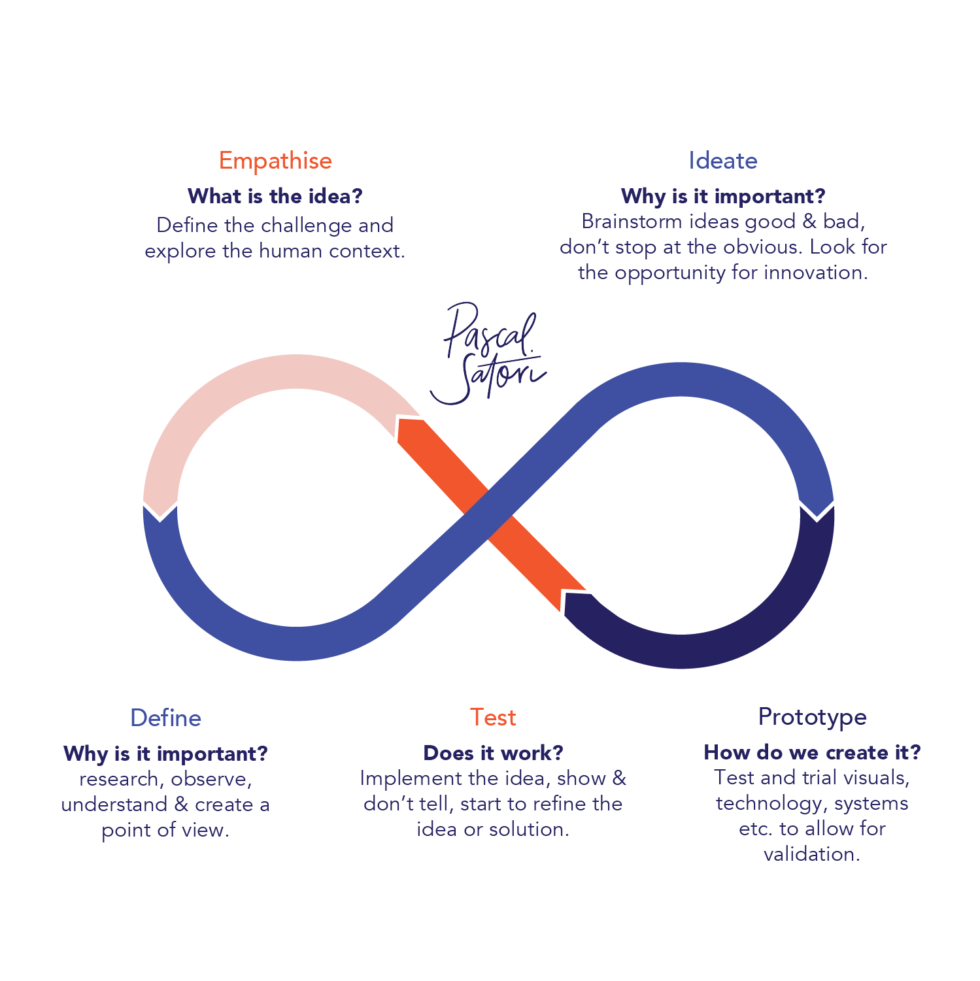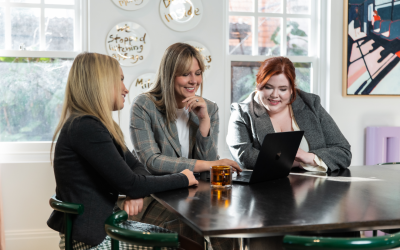Design Thinking is an ideology or methodology that helps us solve complex problems and challenges by driving innovation, creativity, and agility. This methodology is guided by an interactive cycle of research, ideation, prototyping and testing, and has been utilised by some of the world’s biggest organisations (Apple, IBM, Alphabet) to secure a sustainable competitive advantage.
At Pascal Satori, we believe we are all designers. Every single individual out there can think and act like a designer… because design goes beyond the common notion of aesthetics and beauty.
Design is the balance of function and form by definition, and therefore can be applied to any situation where you are creating something that needs to not only work seamlessly, but be designed for purpose – both visually and practically. It’s the thinking that’s powerful, allowing individuals to empathise with human need and create something that is the perfect balance of solution and appeal. This Design thinking can be used by anyone as a ‘valuable tool in ‘designing’ success.’ grounded by understanding and empathy.
Design Thinking is human centric, it’s a mindset and approach that should put us in the shoes of the people we are designing for, to gain a deep empathy and understanding of the challenge at hand. Only then can we effectively create and design products, experiences strategies, services or solutions that truly address the core needs of those experiencing a problem or challenge, and address the out-of-the-box opportunities that haven’t yet been realised by others looking from a singular viewpoint.
Often today, Design Thinking is utilised as a go-to problem solving process used only in crisis management situations. But it is so much more than a step-by-step problem solving process.
Design Thinking is an open ended ideology that can push organisations along an infinite loop of ideation, review and optimisation – driving innovation, creativity and keeping us relevant in the ever changing world we live in.
How do we ‘do’ design thinking?
While Design Thinking is second nature for Creative Design and many other firms such as those in engineering or technology, it has struggled to transcend into all organisations as many management and organisational leaders often find it difficult to adopt the true value of design in driving business value – it’s all a bit too ‘fluffy’ or difficult to measure. That’s why over time, Design Thinking has been constrained to a process with clear steps, check boxes and structure used only to solve problems in time of crisis or difficulty, rather than an ingrained ideology championed by the top, that drives innovation and evolution.
While effective Design Thinking shouldn’t be considered a process (processes are linear and have a clear ‘finish point, which design thinking does not), there does need to be some ‘structure’ around the methodology to avoid the risk of inaction in getting swept up in blue sky thinking, ideation, or endless ideas and concepts for testing. There needs to be actions that further our thinking, and guide the methodology, because without action, there will be no innovation.
To generate these actions, we should approach Design Thinking in terms of stages or phases: Research, Definition, Prototyping and Testing. Each of these areas becomes an infinite loop that paves the way for future thinking. We don’t just stop once we have a proposed solution, we keep the innovation rolling, we review and revisit each of these areas to ensure continuous improvement and optimisation.
Research
We can go about our research in many ways, discover, read, explore, interview, talk-to and involve people and teams. We research to help us understand and define the challenge, but it’s not a simple statement of problem and solution.
The way in which we define and state our challenge is important to think about and should be phrased in a way that allows for creativity in how it could be addressed. Ask yourself why– and always bring it back to the ‘why’.
For example, “we need to create a new booking tool for our restaurant” – by defining our challenge in this way, we can inhibit the creative process and limit our thinking. In this scenario we might create a great booking tool, but are we just developing a single solution based on pre-determined outcome? We’re not looking at the whole picture and asking why?
Design Thinking might state this challenge in another way, for example “we need a simple, streamlined way for our customers to book a table at our restaurant”.
Suddenly we open up a host of new options and ways to approach this. We are driven to ask more – how do our customers currently book? Why is this difficult? How would they prefer to book? Etc.
As Jeanne Liedtka in Harvard Business Review eloquently puts it – “asking a more interesting question can help teams discover more-original ideas’.
The Ideas!
When we truly understand the challenge, we can come up with the ideas! Time to brainstorm. Gather the troops, use your people, no judgement, no silly ideas, everything is on the table! Get creative, think broadly, seek inspiration from the world around you and your experiences within it. Even the most out-there or extreme concepts might just have a grain of credibility that forms the building blocks of an amazing, transformational solution. Ideation should ideally also involve those that are living with the problem, whether it be a business, team or client, because often they will bring a unique perspective based on their close relationship with the problem or challenge.
The Prototyping
This term can sound super technical, and to some, slightly intimidating, but it’s not as scary as it sounds. Prototyping is another way of modelling or experimenting. It’s putting the ideas into action and testing them to see if the results will meet the needs of whom you are designing for. You may have multiple prototypes, and be continually refining or revisiting old prototypes. But prototypes should always be evolving and not a one-and-done final solution.
The Testing
Time to test our ideas and prototypes. This is an opportunity to ask ourselves some more questions – Does it address the issue? Does it meet needs of those you are designing for? Why does this solution work vs that? What could we improve? What does/doesn’t work? How to do they react or respond to this?
Testing might help uncover potential issues, it helps you learn more and understand how to improve your prototype and continue the innovation loop of optimising and refining your ideas.
The Design Thinking Loop
This is not the end – Design Thinking is not a linear approach with a clear start and finish line. It’s not a structured process that can easily be documented and marked off as complete. Nor is it a one-off meeting or workshop, or crisis planning tool, that will solve all your problems. We need to reposition Deign Thinking from ‘effective problem solving process’ to ‘methodology that fuels innovation, agility and adaptability’.
The world doesn’t stand still and dynamic businesses and organisations will always be faced with new challenges. Adopting Design Thinking as an ideology to drive innovation will help to better understand those challenges, and develop plans that rise to those challenges, maybe even before they arise.
Our Pascal Satori founder Paris Young recently spoke to Marketing Mag about Design Thinking, have a read and discover more here!




